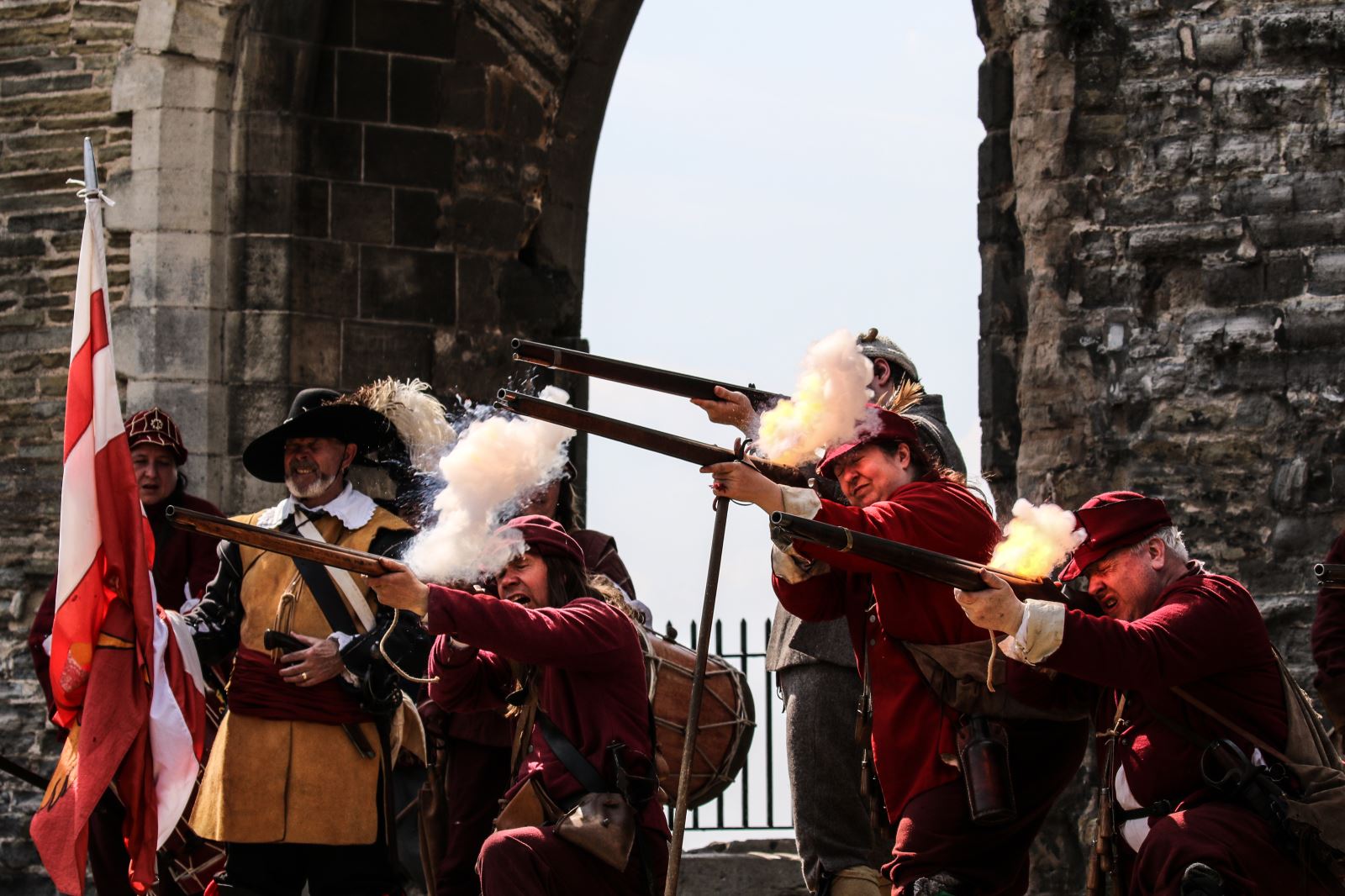Bloody Battles and Pivotal Plots: A Deep Dive Into The English Civil War

Today we’re stepping back in time to the days of bloody battles, skirmishes and sieges, deep into the heart of Britain’s deadliest conflict - the English Civil War.
One of the most turbulent times in British history, Nottinghamshire played a pivotal role this richly dramatic era, as King Charles I’s Royalist army and Oliver Cromwell’s Parliamentarians fought to control the country in a battle over the power of the monarchy and the rights of parliament.
In 1642, Charles I was faced with growing discontent with his rule. Amongst an increasingly tense backdrop of war in Europe, religious conflict, and debt, Charles I came to Nottingham Castle and raised his royal standard at Derry Hill (now Standard Hill) to demonstrate his authority and effectively started the Civil War. Nottingham was chosen for its central location in the heart of England, the midpoint between the largely Royalist north and west and a broadly Parliamentarian south and east.
The monarch had expected the people of Nottingham to fall over themselves to take up his royal cause, hand over their gunpowder and join his army, but the people proved harder to persuade. Shortly after Charles I left Nottingham to gather support for his cause in Shrewsbury, the Castle fell into Parliamentarian hands.
This dramatic period in history was characterised by divided loyalties, not only within towns and cities, but within families and homes, as was the case at Holme Pierrepont Hall. Two brothers living in the hall held opposing views, with Henry, Marquess of Dorchester supporting the King and his brother, William being a close friend and supporter of Oliver Cromwell. Being on opposing sides and with their mother living at Holme Pierrepont Hall the house was spared of attack, even though battles took place very close by.
.jpg)
Other areas in the county were not so lucky. The Nottinghamshire town of Newark, situated on the banks of the River Trent, was a Royalist stronghold and many fierce battles were fought at the Castle and other key sites. Newark came under siege from the Parliamentarians in 1643, 1644 and 1645-46 and as the fighting raged, the population suffered disease and famine.
Many landmarks associated with the conflict and vestiges of the violence remain, like the cannonball hole in the spire of the parish church, and the remaining walls of Newark Castle, which was partly destroyed in 1646, while the National Civil War Centre preserves the stories of gunpowder, plague and plot from this important era of British history. The town’s Civil War history spills out of the museum and threads through the streets with the National Civil War Trail, an immersive augmented-reality experience that places you in the midst of a siege-torn town.
Several Royalist attacks on Nottingham were made from Newark, with the town successfully seized in 1644, but the strategic stronghold of Nottingham Castle remained under Parliamentarian control throughout the war.
.jpg) Image credit Andy Jamieson via Geograph.
Image credit Andy Jamieson via Geograph.
The nearby town of Southwell played its own significant role in the English Civil War; it was here that King Charles I spent his last night as a free man. In May 1646, Charles I left Newark for Southwell, disguised as a clergyman. He spent a night at the Saracen’s Head – then named the King’s Head – before visiting the Archbishop’s Palace to strike a deal with the Scottish Commissioners, believing he had secured sanctuary from Cromwell and the Parliamentarians. The Scottish Commissioners betrayed the King and handed him over to the Parliamentarians for a substantial fee, and the king was imprisoned at the nearby Kelham Hall.
Many of Southwell's historic buildings and landmarks suffered during this period, with the Archbishop's Palace and Southwell Minster bearing scars from the conflict; the blows from swords are clearly visible in the famous Leaves of Southwell – stunning naturalistic carvings that adorn the Minster's Chapter House. Oliver Cromwell's troops destroyed monuments and graves for lead and other valuable materials. At the end of the war, only the Great Hall still stood in the Archbishop's Palace.
Though the Royalists won early victories, the Parliamentarians ultimately triumphed through combination of parliament's alliance with the Scots and the formation of the New Model Army. King Charles I escaped to the Isle of Wight in 1647 and encouraged discontented Scots to invade. This 'Second Civil War' was over within a year, and King Charles I was tired for treason and executed in 1649.
.jpg)
However, that didn’t mean the destruction was over in the new republic. In 1651, the remains of the war-ravaged Nottingham Castle were destroyed with gunpowder, much to the annoyance of Oliver Cromwell, to prevent it from future military use. Only the subterranean structures of the medieval castle survived, and it wasn’t until 1679 that the Ducal palace which can be seen today was constructed by William Cavendish, Duke of Newcastle.
Another beautiful castle in the area, Belvoir Castle, suffered the same fate. During the war, it had been of the more notable strongholds of the king's supporters and King Charles spent a night here on his way into Lincolnshire. It was destroyed in 1649 by parliamentarian forces, and later rebuilt by the Earl of Rutland as a mansion house. It was not until 1830 that it was converted back into the traditional gothic style castle we see today, with towers, turrets and battlements.
Learn more here:
If you're intrigued to learn more about this fascinating era of British history the National Civil War Centre has made a huge range of projects available on their website, with home learning ideas great for children through to resources for adults wanting to explore this richly dramatic era. From guided tours to interactive games and illuminating podcasts there is lots to keep minds young and old occupied.
If you're interested in planning a future visit to immerse yourself in this important era ocne it is safe to do so, a Civil War trail through Southwell, Newark and Nottingham is available to download here.
This blog was written by Claire Jones, Marketing Assistant at Visit Nottinghamshire.
Related
Comments
Ricthevic Very well put together. The National Civil War Centre is an amazing place to visit. Not only does it make the British Civil Wars come to life but you can immerse yourself in Newarks history. The Tudor Hall, formally the Magnus School is also inspiring. Laura Chase Glad to found that updates and such suggestions from experts are really useful as well. I hope you will get great help on https://www.essayontime.co.uk/ and clear your thoughts. There might be the people who need the direction and facing problems like this can get wise help. Ian Myles Cool place and it reminds me how I wanted to <a href="https://writer-elite.com/literature-review-writing-service/";>buy literature review online</a> on the same topic. After reviewing it, I was told that the review is completely ready for defense. Klais Yes, there were many different wars going on. I think everyone already knows and understands this, because conflicts happen all the time. But the Gettysburg war was particularly noteworthy, I think it is worth reading about it here https://studydriver.com/battle-of-gettysburg-essay/ , it will help to understand the background and what not to allow so that this nightmare did not happen again. Any fighting and war is bad and should not be allowed to happen! anna45h What does League of Legends owe its popularity to? Let's http://escores24.com/game/lol/ try to figure it out. The project’s hallmark from Riot Games was a bright and memorable visual style that effectively emphasized various unusual characters. In comparison with Dota, League of Legends has several successful gameplay solutions, such as a more compact map and higher dynamics of matches. Still, the secret of success lies precisely in the visual component and aggressive marketing.

 to add an item to your Itinerary basket.
to add an item to your Itinerary basket.











